Peter Reekie considers Jewelcraft Ltd v Pressland, in which the Court of Appeal has clarified what is a ‘house’ for the purposes of enfranchisement under the Leasehold Reform Act 1967.
When is a shop not a shop? In the context of enfranchisement, the answer is: when it’s a house.
When it was enacted, the Leasehold Reform Act 1967 (LRA 1967), broadly, gave tenants of houses the right to buy the freehold, providing a number of eligibility criteria were satisfied. They included low rent and low value tests, and a residency test for the tenant. Over the years, these three criteria were largely removed by amending legislation.
Subject to certain exceptions, for the tenant to qualify, there are now, very broadly, three main requirements in the LRA 1967 (although there are other requirements in certain circumstances). In outline, they are as follows.
• There must be a long tenancy. A long tenancy is one granted for a term certain exceeding 21 years, but there are certain exceptions.
• The tenant must have held the lease for at least the last two years.
• It must be of a ‘house’ as defined.
Although the legislation is quite complex, in practice, it is this last criterion that effectively prevents such premises as offices and hotels from being subject to enfranchisement (see the Supreme Court decision in Hosebay Ltd v Day; Lexgorge v Howard de Walden Estate [2012] UKSC 41). However, this still leaves some properties where there is doubt about whether they are ‘houses’ under the legislation. The key issue is the wording in section 2(1) of the LRA 1967 which, when defining a house, uses the phrase ‘any building designed or adapted for living in and reasonably so called’.
In our case this month, Jewelcraft Ltd v Pressland [2015] EWCA Civ 1111, the building consisted of a purpose-built ground floor shop with a flat on the first floor. It was part of a parade of shops built in the 1920s. Originally there was an internal staircase between the two floors, but this had been removed and replaced by an external staircase in the back yard. The floor spaces of the flat and the shop were roughly equal. The building had been let on a 99-year lease now owned by the claimant company tenant. The whole premises had been sublet to Martin Newsagents Ltd.
Lord Justice Patten, giving the judgment of the Court of Appeal, held that claims to enfranchise buildings comprising shops with accommodation above should not be dismissed, because the building is, ‘as a matter of ordinary speech, best described as a shop’. He pointed out that Tandon v Trustees of Spurgeon Homes [1982] AC 755 had established that shops with accommodation above, as a matter of law, can reasonably be described as ‘houses’ within section 2(1) provided that ‘a material part of the building is designed or adapted for and used for residential purposes on the relevant date’. Further, in Hosebay, the Supreme Court had explained the decision in Tandon as one that turns on user rather than appearance. He went on to say:
‘County Court judges will doubtless be adept at dismissing cases where the conversion of part to residential user is not genuine or substantial or where the premises are not of the type which, as a matter of policy, Parliament intended to fall within the 1967 Act. A block of offices with a caretaker’s flat would be such a case. But, these cases apart, there ought to be no warrant from now on for distinguishing between similar types of building solely on the basis of their external appearance or their internal layout.’
The decision is a welcome clarification of the application of the LRA 1967 to mixed-use premises that will, no doubt, particularly please many tenants.

























